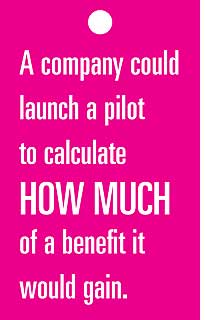The RFID Research Center at the University of Arkansas has been working with Dillard’s and other apparel retailers to find out whether tracking items with RFID tags could affect inventory accuracy and potentially sales. Now, the center is aggregating the results of these pilots and those conducted by other retailers to create baseline data—or averages—to determine the benefits RFID can deliver to apparel retailers. Such information is critical to helping companies develop a business case for adopting RFID technology, and should be the focus of more academic research.
Bill Hardgrave, director of the RFID Research Center, says retailers that have run pilots have offered to share their results with the center in exchange for information about the average benefits other retailers have seen. This will let them determine whether their results are above, below or near the average. These retailers are allowing Hardgrave to use the data in aggregate, but not to disclose their individual results. (The results will be revealed at RFID Journal‘s RFID in Fashion 2009 event in New York, on Aug. 12-13.)
|
|
This aggregation of data is valuable because companies evaluating RFID have struggled to ascertain what their return on investment will be. Numerous retailers have run pilots to learn whether the technology can reduce out-of-stocks and increase sales. Each pilot proves it can, but still more retailers go through the time and expense of running pilots.
Baseline data could help companies evaluate the potential ROI before running a pilot. That’s because if 50 pilots reveal that, on average, RFID helps boost inventory accuracy from 65 percent to 98 percent, companies don’t need to run a pilot to prove this. If the 50 pilots demonstrate that improved accuracy and management of store inventory with RFID leads to sales increases of, say, 3 percent to 10 percent, then companies can build a business case around that data.
If you’re an apparel retailer with 100 stores and an average store revenue of $500,000 per year, a 3 percent increase in sales would amount to $1.5 million, a 10 percent increase to $5 million. Now, a company can get bids from RFID solution providers on the cost of outfitting each store. Let’s say the total cost of an enterprise-wide system is $1.5 million; that means the company is likely to begin achieving an ROI after just one year if it’s at the low end of the average benefit, and sooner if it’s at the high end. With this knowledge, the company can launch a pilot not to prove the technology works or to determine if there will be a benefit, but rather to calculate how much of a benefit it will gain. The pilot can also focus on establishing the most cost-effective way to deploy the RFID system in the retailer’s store environment.
It would be useful to have baseline data for different departments within retail stores. For example, if information were published on the average margin, out-of-stock rate and improvement in sales with RFID for items in the shoe, men’s suit and women’s accessories departments, companies could determine which department would likely yield the highest ROI through the use of RFID. Retailers could then decide to start by deploying RFID in, say, the shoe department of all their stores, versus men’s suits.
This approach, which makes it easier to build a business case, could spur adoption in other industries as well. In health care, for instance, it should be possible for researchers to gather baseline data on the reduction in capital expenditures and maintenance costs for tracking major classes of assets, such as wheelchairs. Companies could get bids on creating an asset-tracking system in their facilities and determine whether it makes economic sense to deploy such a system.
Much of the research being done in universities has focused on improving the performance of tags and interrogators, developing systems for sharing data within an industry, or simply proving the technology works. But without a clear understanding of the ROI level a company can expect from an RFID system, adoption will continue to be slow, as each enterprise conducts extensive tests to determine the benefits for itself.
Photo: (c) 2008 Airbus S.A.S



